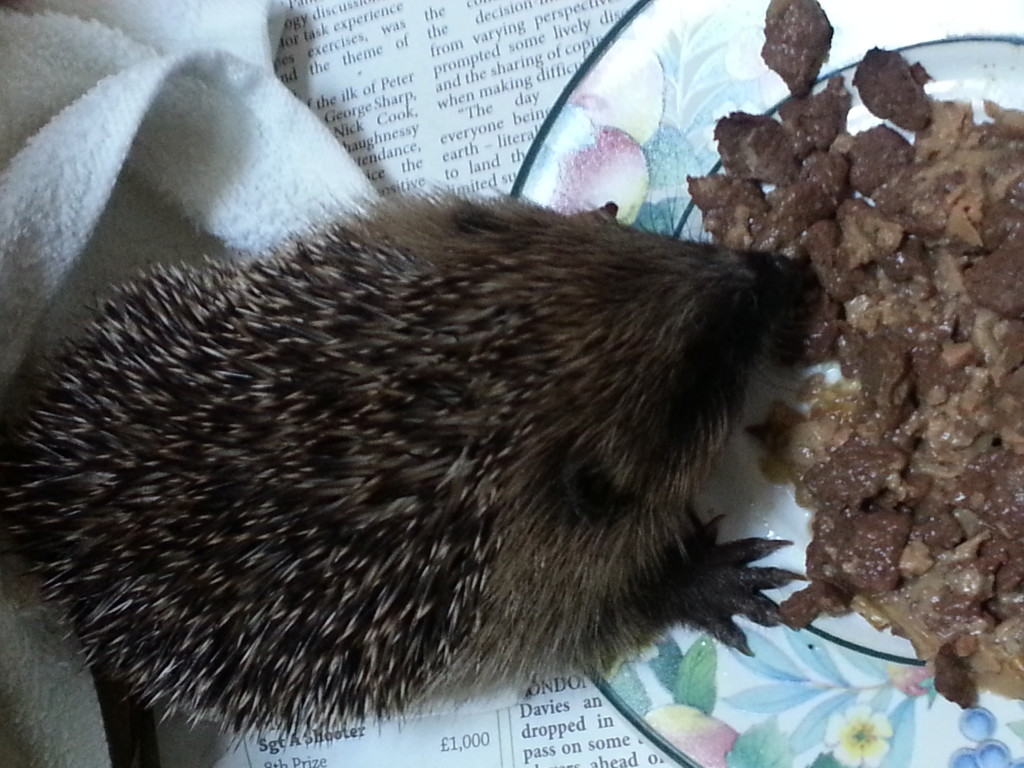A Spiky Tale: Hedgehog Rescues at Loch of the Lowes
This month began with a bang, not only did the volunteer assistant rangers and I get our first sighting of a pine marten, but we also came across a wee hedgehog looking rather lost and confused in the road. We observed and watched its behaviour for some time to decide whether or not it was a true orphan and required rescuing. It soon became apparent it was not alone as we were being watch by a very still, but super alert adult hedgehog on the wall above the road. First thoughts were that the juvenile had fallen from the wall and couldn’t find its way back up to its mother, but it is very unusual for hedgehogs to be out during the day as they are nocturnal creatures and spend their days sleeping in a nest. A few steps on and the story unfolded, as a second juvenile was found frantically running up and down . This now began to look more like a case of possible nest disturbance – possibly by a person or dog or accident when nearby farm equipment was being moved. Juvenile hedgehogs live in family groups in nests and tiny babies will only leave a nest if there is a problem or when they are at weaning age and ready to learn to forage for food at night. Young hedgehogs will make a very shrill, loud, call if they are in distress and this is exactly what we began to hear.

Did you know? In hedgehog families the Males have no role in rearing the young called ‘urchins’. The female gives birth, after a 35 day pregnancy, to typically 4-5 babies. She will have prepared a nest as a nursery under a hedge or in a pile of leaves, or frequently a shed or outbuilding.
In this case it appeared their nest had been accidentally disturbed on the local farm and sadly 2 other siblings had already met their fate on the road. So the luckier two juveniles and adult hedgehog were picked up, with the plan to release in a safer location after dark that evening.
When and how to assist a hedgehog
A hedgehog is in real trouble if:
- The hedgehog is out during the day, and is looking wobbly or disorientated.
- The hedgehog is asleep away from its nest e.g. lying in the middle of a garden or path during the day.
- It is a single orphan on its own- after surveillance to check if mum is around.
- Once you have established that a hedgehog is in need of aid, pick it up with thick gloves and put it in a cardboard box with newspaper and an old towel. Thick gloves help, as their spines can hurt and they sometimes bite, it also prevents the transfer of human smell.
- If the hedgehog is very dull/flat a hot water bottle wrapped in a towel, (or any plastic bottle filled with warm water), can be provided. Ensure the hedgehog has ability to move away from heat if it becomes too warm.
- Do not try to force the wee hog to eat or drink – this can be traumatic and keep handling to an absolute minimum to prevent stress.
- A small bowl of water should be provided and then contact and take the hedgehog to a professional wildlife rehabilitator.
- Always get expert advice on what to feed your hog- the wrong food can make them very very ill.
At dusk we attempted to release the hedgehog family, the adult female and one juvenile did set of from the box foraging and finding their way, but sadly the smaller of the two juveniles began a high piping distress call and circling frantically. It was therefore decided that he needed to be assisted and after initial first aid from the staff here at Loch of the Lowes he was taken to a professional wildlife rehabilitator.
Rearing of orphaned hedgehogs is not easy and should be undertaken by wildlife trained individuals. If you uncover a nest with urchins (young hedgehogs who have not been weaned and usually have very few spines) you should not disturb it, but covered over again and left. The mother will usually return, if there is no human scent on the babies.
If you are ever unsure about what to do contact your local specialist wildlife rescue centre for advice or the SSPCA 03000999999 or RSPCA 0300 1234 555 .
The happy postscript to this story is that “Hamlet”, as the smaller hoglet was named, has progressed quickly in care and has now been successfully rereleased here on the reserve to re-join his family. However, another unrelated wee hoglet was also found on our footpath by a member of the public last week and so we had to repeat the whole process- but this wee one is also doing well.
Sarah Close, Volunteer Visitor Centre Assistant
Help protect Scotland’s wildlife
Our work to save Scotland’s wildlife is made possible thanks to the generosity of our members and supporters.
Join today from just £3 a month to help protect the species you love.
Preface
This month began with a bang, not only did the volunteer assistant rangers and I get our first sighting of a pine marten, but we also came across a wee …
